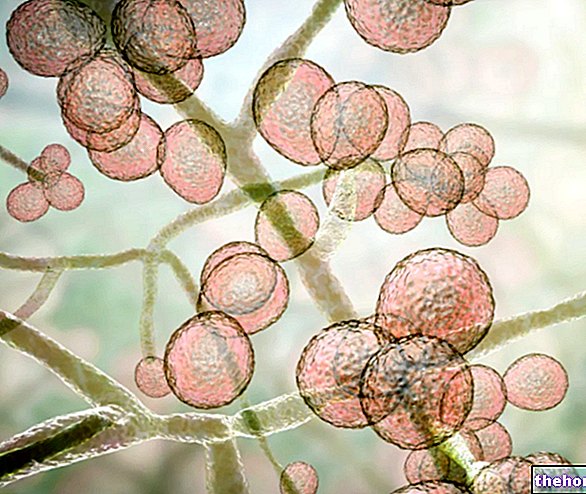The evolution of the human species is guaranteed by the meiosis of the germ cells and their subsequent union (fertilization). In this way, the new generations inherit half of the genetic patrimony from the father and half from the mother.
Since bacteria reproduce asexually, by simple binary fission, their evolution is guaranteed by two main mechanisms: that of mutations and that of recombinations.
MUTATIONS: random event that manifests itself with alterations and substitutions at the level of the nucleotide sequences that make up the bacterial genome.
RECOMBINATIONS: derive from gene transfer mechanisms: a donor bacterium transfers mucleotide sequences to the recipient bacterium, which integrates them into its genome according to a HOMOLOGOUS RECOMBINATION mechanism. All this leads to the acquisition of new characteristics, such as the capsule, the ability to produce particular toxins, factors of resistance to antibiotics, etc. ..
In the bacterium the genome is contained in the single chromosome and sometimes also in extrachromosomal environments, called PLASMIDS, which have the same superspiralized structure, but a smaller diameter. The plasmids are endowed with autonomous replication and can encode, for example, for toxins, pili , adhesins, bacteriocins or resistance factors; some plasmids can also integrate into the bacterial genome and subsequently become independent; in these cases they are called EPISOMS. In general, therefore, in the plasmids we find the genetic information of auxiliary characters, not essential for the survival of the bacterium.
Some plasmids have a narrow spectrum of potential hosts, while others have a broader spectrum (which means they can be transferred to different bacteria).
To transfer the genetic material, then plasmids or genomic sequences, the bacteria have worked out three different mechanisms, called: transformation, conjugation and transduction. To these, a fourth can be added, called TRANSPOSITION, through which genetic material is transferred from one area of the chromosome to another, or from the plasmid to the chromosome, within the bacterium itself.
Passage of free DNA fragments, originating from bacterial lysis, to a recipient bacterium.
Gene transfer through physical contact between two bacteria, of which the donor is called F + (positive fertility) and has a conjugation lead, while the recipient F-.
The transfer is mediated by a bacterial virus called bacteriophage.
TRANSFORMATION: the transformation process can be divided into distinct stages:
1) link between DNA and cell
2) entry of DNA into the cell
3) recombination of free DNA entering the recipient bacterium
4) phenotypic expression
A DNA to be transforming must be:
1) double helix
2) with molecular weight higher than 106 Dalton
3) have a "high analogy with the DNA of the recipient cell
The receptor cell, for its part, must be in a physiological state called competence. A cell is competent when it is at the end of its exponential or logarithmic growth; in this phase, in fact, protein synthesis is maximum and factors of competence (proteins that allow DNA to enter).
CONJUGATION: consists in the direct transfer of genetic material through physical contact between two bacterial cells.
Some bacteria contain a plasmid, called factor F, which codes for proteins that form the conjugation pile. This plasmid, endowed with autonomous replication, has genes that allow it to replicate and transfer from one F + bacterium to another (F-).
Stages of conjugation: An F + bacterium meets an F- bacterium and a bonding bridge is formed. At this point the plasmid begins to replicate itself with a mechanism called rolling circle (in the 5 "- 3" direction), during which one of the two hemielics passes through the pilus.At the end of replication and transfer, we have two F +, since the first keeps the copy of the plasmid, while the F- receives the second hemiel, which then duplicates and forms the plasmid.
Sometimes (rarely) in an F + cell the plasmid can integrate into the chromosome. The new cells where the plasmid is integrated are called HFR (high frequency of recombination). In these cells the integrated plasmid transmits its characteristics to the chromosome, such as that of transferring from a bacterium A to a bacterium B; therefore the genes of the former can combine with those of the latter.
If we put an HFR bacterium in contact with an F- the conjugation bridge is formed, which sends a gene transfer signal for which a nuclease cuts a "helix, the chromosome begins to replicate with a rolling circle mechanism, and the copy it passes into cell F starting from the cut point.
The passage of the "whole chromosome takes about 90", but the conjugation bridge is fragile and often breaks before the transfer is complete, so only the head of the plasmid and some genes close to it pass; the terminal part, on the other hand, containing the factor F, does not pass. Consequently, the F- cell does not become HFR and neither does F +, but acquires only some of the characteristics of the donor bacterium.
The donor DNA can recombine with the chromosome of the receiving cell giving the bacterium new genetic characters. Other times the DNA can be degraded and there is no change.
In addition to the F factors there are also the so-called R factors (which lead to antibiotic resistance); they are always plasmids that contain the sequences of F factors, to which others are associated for resistance to antibiotics. Then there are COL factors, which code for proteins called colicins or bacteriocins, that is substances with bactericidal action, with which the bacterium defends itself and attacks the other cells to occupy the colonization sites.
There are also ENT factors, which code for enterotoxins and which are typical of some Escherichia Coli stems (normally present in the organism), capable of producing active enterotoxins on the mucosa of the small intestine.
Sexual pili are typical and unique of GRAMs - but conjugation also occurs in GRAM +, which possess plasmids that synthesize particular proteins, which - secreted externally - lead to aggregation between F + and other F- bacteria (without resorting to al pilo che non c "è). Conjugation is however a rare event.
Other articles on "Bacteria: Transfer of" genetic information "
- bacterial toxins
- bacteria
- characteristic bacteria
- bacterial cell
- bacteria accessory structures
- Bacteria: transfer of genetic information
- Antibiotics
- Categories of antibiotics
- Antibiotic resistance




























